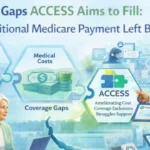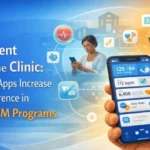All About Transitional Care Management CPT Codes 99495 and CPT 99496

Once a patient is discharged from the hospital, getting him/her back to good health without any risks of hospital readmissions becomes the foremost responsibility of a caregiver. To achieve this goal, a care model, known as TCM is introduced by the Centers for Medicare and Medicaid Services (CMS).
Transitional Care Management (TCM) is an important component of the transitional healthcare model and medical management addressing the vital aftercare period once a patient is discharged from the hospital. TCM is a critical caregiving model for both caregivers and healthcare providers as it demonstrates a commitment to patient well-being during a fragile transition loaded with prolonged health risks and uncertainty.
Healthcare providers have been successfully using TCM CPT Codes 99495 and 99496 to claim the right reimbursement for treating patients with complex medical conditions in the immediate post-discharge period.
Table of Contents
ToggleWhat Are TCM Codes & Their Role In Post-discharge Care?
As per the American Medical Association (AMA), CPT® codes provide physicians and other healthcare professionals with an established uniform language for coding medical services and procedures to streamline real-time patient data reporting and increase billing efficiency and accuracy.
According to the CMS guidelines for Transitional Care Management, reimbursement is limited to the treatment and post-discharge care of patients with a disease that necessitates medium or high-level decision-making. This includes time spent coordinating with the caregiver for the patient’s specific medical or psychosocial requirements.
The eligible methods to enhance patient or caregiver communication include not only direct patient contact but also interactive contact via telephone and digital channels. Healthcare providers using clinical software and digital health platforms can utilize these TCM codes to further embrace virtual care technologies.
Here’s a closer look at TCM codes and their current payment rates for physicians, clinicians, and other qualified healthcare providers.
Guide to TCM CPT Code 99495
99495 is a CPT code that reimburses transitional care management services for patients who require “medical decision-making of at least moderate complexity.”
The practitioner must communicate with the patient and/ or care giver within two business days of discharge and may involve direct contact, telephone, and electronic methods.
Also, one in-person visit is required within 14 days of the patient’s discharge from the hospital. This visit cannot be conducted digitally or virtually and should not be reported separately.
Who Can Bill For CPT Code 99495
Eligible billing practitioners for CPT Code 99495 include physicians or other Qualified Health Professionals (QHPs), including Physician Assistants (PAs) or Nurse Practitioners (NPs). Also, a few Non-physician Practitioners (NPPs), as authorized by state law, Certified Nurse-midwives (CNMs), and Clinical Nurse Specialists (CNSs) can also bill for TCM codes.
The average one-time reimbursement rate for CPT Code is approximately $209.02 and varies by location.
Guide to TCM CPT Code 99496
TCM can be reimbursed under CPT 99496 for patients who require “medical decision-making of high complexity.”
Communication between the patient and/ or care giver and the practitioner must commence within two business days after discharge via “direct contact, telephone, and electronic medium.
Also, one face-to-face or in-person visit to the physician’s office is required. This visit must be completed within 7 days of the patient’s discharge and should not be reported separately.
Who Can Bill For CPT Code 99496
Physicians or other Qualified Health Professionals (QHPs), including Physician Assistants (PAs), Nurse Practitioners (NPs), Non-physician Practitioners (NPPs), Certified Nurse-midwives (CNMs), and Clinical Nurse Specialists (CNSs) are eligible billing practitioners for CPT Code 99496.
The average one-time reimbursement rate for CPT code 99496 is approximately $281.69 and varies by location.
When Do TCM CPT Codes 99495 and 99496 Apply?
The CMS states that “TCM services begin the day of discharge and are formulated with a goal to assist a patient in returning to the community following a stay at a specific type of facility covered by Medicare.”
These community settings and facility types are identified as domiciliary care, nursing homes, and assisted living facilities, including:
- In-patient acute care hospitals
- In-patient psychiatric hospitals
- Long-term care hospitals
- Skilled nursing facilities
- Inpatient rehabilitation facilities
- Hospital out-patient appointments
- Partial hospitalizations
- Community Mental Health Center hospitalization
Billing Guidelines For Transitional Care Management Codes
TCM differs from other care management codes for Remote Patient Monitoring (RPM) and Chronic Care Management (CCM). It can be billed during the same months as care provided under those models and used in conjunction with Principal Care Management (PCM).
The CMS facilitates coordination of services by stating that CNMs, CNSs, NPs, and PAs may also provide the non-face-to-face services of TCM incident to the services of a physician. At a time, only one healthcare provider is allowed to bill for the TCM services during the 30-day period following the hospital discharge.
Both TCM codes 99495 and 99496 are associated with primary care after discharge from the hospital. In certain cases, a specialist may be involved in managing the patient’s condition that necessitated hospital admission before.
Other billing points to consider include:
- Only one physician or NPP can report TCM services.
- Report once per patient during the TCM’s 30-days period.
- The same healthcare provider can discharge the patient, record discharge services, and bill TCM.
- Face-to-face visits on the same day as the discharge day do not count.
- Provide necessary E/M services separately to address the patient’s clinical difficulties.
- TCM services cannot be billed throughout the post-operative global surgical period.
Simplify TCM Codes & Billing With HealthArc’s Comprehensive Healthcare Solutions
Streamline your Transitional Care Management (TCM) services with HealthArc’s advanced TCM clinical software and digital health platform focused on smooth patient transition, reduced readmission rate, seamless communication, and enhanced overall patient engagement.
Our platform is designed with the latest CMS guidelines, ensuring optimal outcomes for both patients and providers.
Request a free demo or feel free to talk to our team at +201 885 5571 to learn how we can help your organization achieve its long-term transitional care management goals.
Frequently Asked Questions (FAQs)
TCM refers to services provided to patients transitioning from an inpatient setting (hospital, rehab, skilled nursing facility) back to their community setting. It ensures smooth care coordination, reduces readmission risks, and improves patient outcomes during the 30‑day post‑discharge period.
- 99495: TCM with moderate medical decision‑making and a face‑to‑face visit within 14 days of discharge.
- 99496: TCM with high‑complexity medical decision‑making and a face‑to‑face visit within 7 days of discharge.
Physicians, nurse practitioners (NPs), physician assistants (PAs), clinical nurse specialists (CNSs), and certified nurse midwives can bill for these services, often with support from clinical staff under direct or general supervision.
- Initial contact with the patient or caregiver within 2 business days of discharge (via phone, email, or in person)
- Medication reconciliation to ensure safe post‑discharge care
- Care coordination with specialists, therapists, and community services
- A timely face‑to‑face visit based on complexity (7 or 14 days)
The difference lies in medical decision‑making complexity and timing of the follow‑up visit:
- 99495: Moderate complexity; visit within 14 days.
- 99496: High complexity; visit within 7 days.
There’s no specific time requirement, but providers must document all non‑face‑to‑face activities (care coordination, chart review, patient/caregiver education) performed during the 30‑day post‑discharge period.
Yes. The interactive contact and even the face‑to‑face visit can be performed through approved telehealth platforms if all Medicare guidelines are met.
TCM codes can be billed once per patient per 30‑day transition period. Only one provider may bill for TCM during that period, even if multiple specialists are involved.
- Discharge date and source
- Timing and method of initial patient/caregiver contact
- Date and type of the face-to-face visit
- Medical decision-making complexity
- Details of medication reconciliation and care coordination
On average:
- 99495: Around $160–$170
- 99496: Around $230–$240
Reimbursement may vary by region and payer.
Most Recent Blogs
Categories
Related Blog
- October 30, 2025 | Read Time: 14 mins
Closing the Care Gaps in Elderly Transitions with Transitional Care Management (TCM)
Elderly patients leaving nursing homes, skilled nursing facilities (SNFs), or assisted living...
Learn More- June 5, 2024 | Read Time: 7 mins
CPT Code 99495 For Billing Transitional Care Management (TCM)
As defined by the American Medical Association (AMA), Current Procedural Terminology (CPT®)...
Learn More- May 27, 2024 | Read Time: 10 mins
What Is Transitional Care Management (TCM) & How It Works?
When a patient is admitted in the hospital to treat or manage...
Learn More


